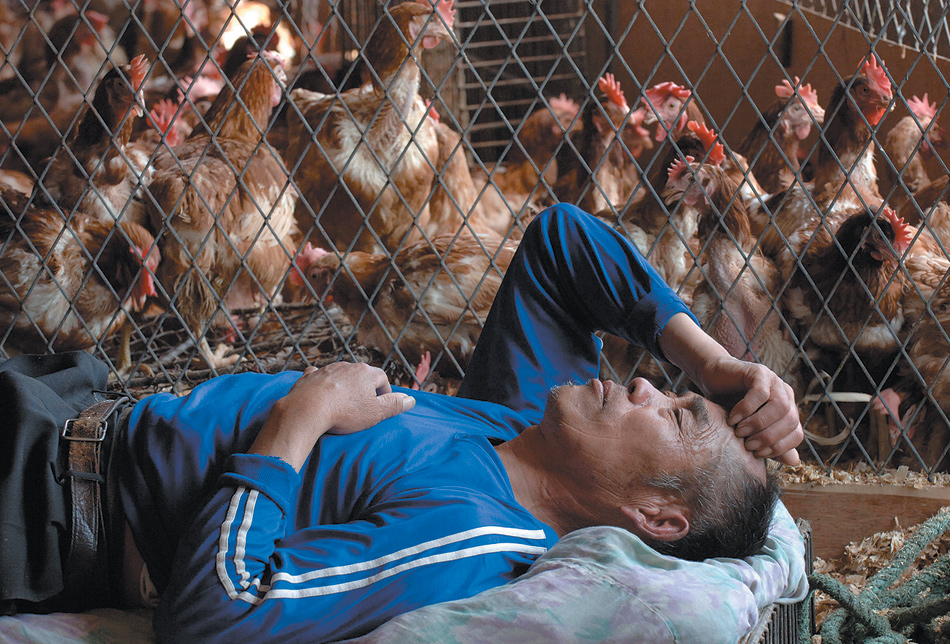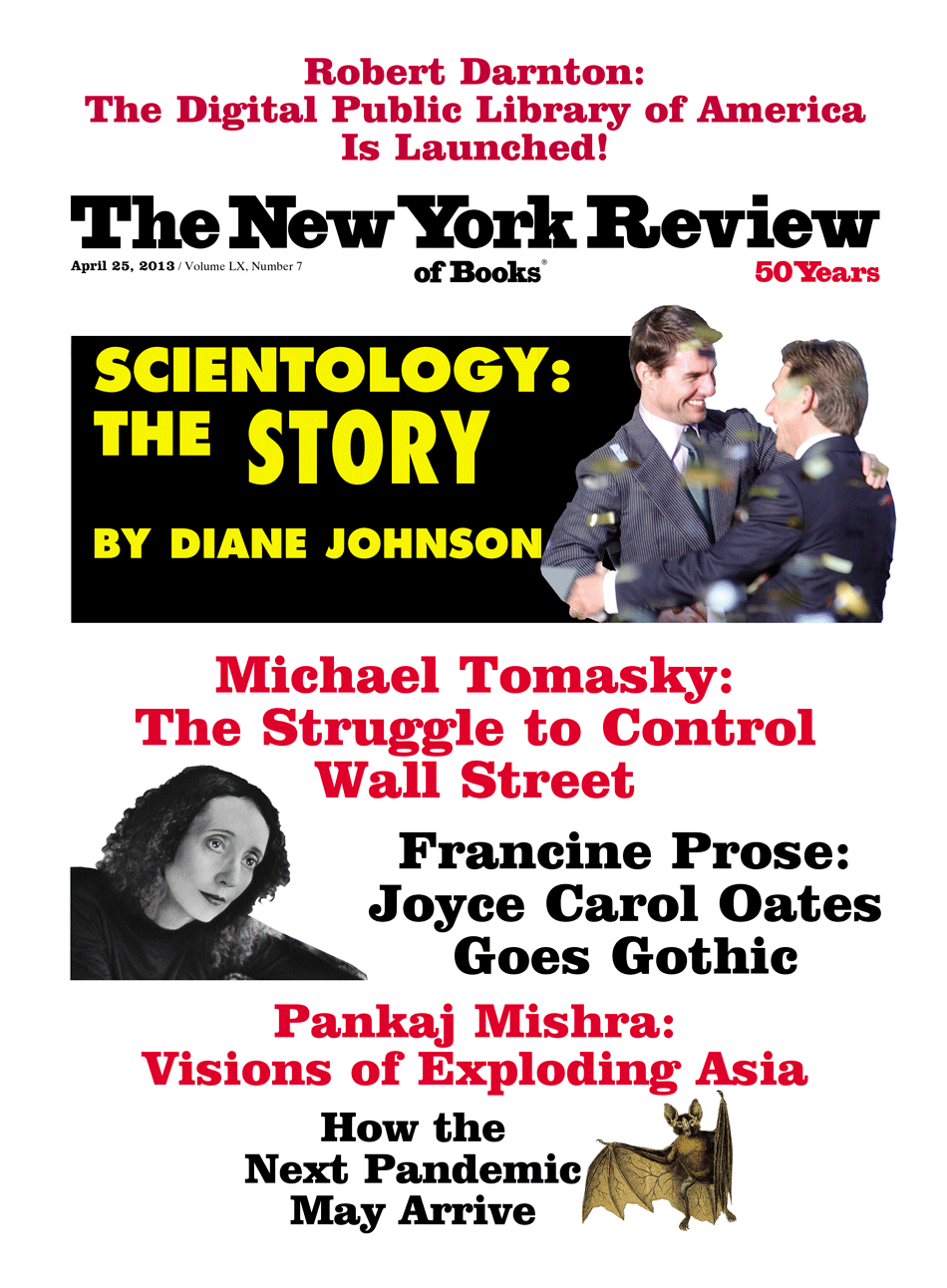For better or worse, Homo sapiens has become the most abundant large mammal ever to roam the planet. We have spread into nearly every conceivable terrestrial habitat. We have increased our fertility and decreased our mortality. We have reengineered ecosystems and food webs and disinterred fossil stores to produce our calories and condition our dwellings. We are seven billion strong, growing at a rate of 70 million people a year.
As E.O. Wilson, both an entomologist and a conservationist, put it, “When Homo sapiens passed the six-billion mark we had already exceeded by perhaps as much as 100 times the biomass [i.e., the mass of the living organism] of any large animal species that ever existed on the land.” He was talking about wild animals. We are only about five times more numerous and probably a little less massive than our livestock—herded, fattened, and medically dosed just for us. Or, as David Quammen puts it in his masterful new book Spillover: Animal Infections and the Next Human Pandemic: we are an “outbreak,” a species that has undergone a “vast, sudden population increase.” “And here’s the thing about outbreaks,” warns Quammen: “They end…. In some cases they end gradually, in other cases they end with a crash.”
If this sounds alarming, it’s meant to. Undergirding his book’s structure, and right there in the subtitle, is the prospect of another major pandemic, what he and various epidemiologists he has consulted call the Next Big One. What will cause it? Most likely, a virus. What kind of virus? A brand new one, or new, at least, to humans. It will likely be a coronavirus. These, like HIV, have genes written in RNA, not DNA. This means it will be quickly mutating and elusive to treat. Where will it come from? Another animal. When a virus from an animal host “spills over” onto us, this is called zoonosis. Quammen estimates that roughly 60 percent of human infectious diseases have originated with animals, including Lyme disease, West Nile fever, the bubonic plague, and all influenzas. Zoonosis is “a word of the future,” he writes, “destined for heavy use in the twenty-first century.”
This insight, of course, is not really new for anyone who has read such books as Laurie Garrett’s The Coming Plague (1994) or Richard Preston’s The Hot Zone (1994) or seen Steven Soderbergh’s film Contagion (2011), in which a virus found in pigs and bats rapidly spreads around the world. Peter Heller’s 2012 novel The Dog Stars takes place after an influenza strain has killed 99.9 percent of humanity. In the films 28 Days Later (2002) and I Am Legend (2007), a rabies-like infection has turned the civilized world into the eaters and the eaten, plus a small band of survivors.
The problem with many bio- apocalyptic scenarios is that they’re ahistorical and unscientific. Viruses that are effective killers, like Ebola, tend to burn out quickly because they annihilate their hosts before germs can spread too far. Viruses that are highly transmissible, like the so-called Spanish flu of 1918, tend to kill only a small percentage of those infected. (The Spanish flu infected 30 percent of the world’s population. It killed about 2 percent.)
Quammen knows this, and is too rigorous a journalist to overdramatize dangers. His central idea is that the study of viruses must also be a study of ecology. By limiting his scope to diseases transmitted by animals as opposed to, say, polio and smallpox (which, though devastating, are diseases only found in humans), he can explore the complex and fascinating connections between us and the animals around us, both wild and domestic. As humans have swarmed the planet, we’ve altered habitats both large and microscopic. The natural world is rapidly disintegrating, or at least reorganizing in vastly unpredictable ways, and Quammen has for years been writing about the consequences. In The Song of the Dodo: Island Biogeography in an Age of Extinction, he identifies his subject as “the extinction of species in a world that has been hacked into pieces.”1
Spillover is a logical sequel. Although diseases can “reside undetected” within intact ecosystems, “ecological disturbance causes diseases to emerge.” We have not only disrupted, fragmented, and interrupted the web of relationships with animals in these places, but we’ve presented ourselves—our very own tissues and cells—as alternative targets for opportunistic microbes.
Many of us will remember the virus SARS as a scary bug that flamed out quickly. But SARS is worth a long look for what it almost was. Quammen guides us back, step by unnerving step, to the time before eight thousand people were infected and 774 died. A seventy-eight-year-old Canadian grandmother delivered the virus to Toronto from Hong Kong in February 2003. Within weeks, it had arrived in the Philippines, Singapore, Vietnam, Thailand, and Taiwan. Here is a typical sequence from Quammen’s book, describing events that took place on March 15, 2003:
Advertisement
Flight CA112 took off from Hong Kong that day carrying 120 people, including a feverish man with a worsening cough. By the time it landed in Beijing, three hours later, twenty-two other passengers and two crewmembers had received infectious doses of the coughing man’s germs. From them, it spread through more than seventy hospitals just in Beijing….
In close-ups, we follow several “superspreaders,” so named for their Typhoid Maryesque ability to infect an unusually high number of people. One was a seafood merchant in Guangzhou, the capital of Guangdong province, two hours from mainland China’s border with Hong Kong, who, during his illness, “gasped for breath, vomited, and spattered phlegm around the ambulance.” He then proceeded to scattershoot an entire emergency room. One of those infected was an unfortunate kidney doctor who was trying to attend his nephew’s wedding, but instead spent a fateful night coughing in room 911 of Hong Kong’s Metropole Hotel, across the hall from the Canadian grandma, who would transport the virus to North America the next day.
Quammen himself checks into the hotel some years later while following the germ trail. He describes how determined scientists eventually traced the SARS virus all the way back to Guangdong province. Quammen characterizes one researcher as having “the instincts of an epidemiologist and the balls of a brass macaque” because he swabs the throats and anuses of every animal he can find. There were a lot. It turns out that Guangdong is “a province of ravenous, unsqueamish carnivores” whose appetites fuel the biggest and most diverse live-animal markets in the world. Eventually, the culpable coronavirus was found in a civet cat, a mammal in the mongoose family, bound for a kitchen pot. More sleuthing showed that civets weren’t SARS’s main animal host. The civet had caught it from a horseshoe bat.
How did the bat and the civet connect with each other? The gruesome live markets of southern China are an enterprising virus’s dream come true: such close quarters and all those stacked cages in a region where increasingly adventurous tastes demand a supply of exotic animals, including horseshoe bats.
As Quammen brilliantly portrays them, the lessons of the SARS virus are unnerving. We are a populous and hungry species eating our way across the taxonomic map. Our livestock are kept in close quarters with wild animals, and we travel over oceans in a day. The SARS outbreak could easily have been worse. A bigger disaster was averted because Chinese authorities were ultimately organized and ruthless about quarantining (even public spitters were fined $300). The hospitals in China and in Toronto were excellent. (What if the disease had broken out in New Delhi?) Moreover, as Quammen explains, SARS patients got very sick before the height of infection, helping them get off the streets and buses before they were too contagious. With many other viruses, the reverse is true. “When the Next Big One comes,” he writes, “we can guess, it will likely conform to the same perverse pattern, high infectivity preceding notable symptoms. That will help it to move through cities and airports like an angel of death.”
In other chapters, Quammen traces the Hendra virus in Australia (where bats infected horses and horses infected people), Ebola in Congo, Nipah virus in Malaysia (from wild fruit bats to domestic pigs to farmers), and the spread of HIV from its origins in Central Africa (a chimp probably infected a hunter in Cameroon as early as 1908). Quammen visits victims of Marburg virus and the labs with people studying malaria, Lyme disease, and Q fever, a bacterium whose first cases were diagnosed in Australian abattoir workers in 1933. All these routes allow him to dip into the science and mathematics of transmission, the history of virology, and the evolutionary biology of these unpredictable organisms. As a testament to how difficult the detective work can be with zoonoses, we still do not know exactly what the main animal host is for Ebola. Since Spillover came out, Uganda has had another outbreak, and a stronger case has been made for transmission from pigs and monkeys.
Lest we be tempted to attribute vicious agendas of conquest and supremacy to the viruses, Quammen warns against the impulse to personify them:
Among the most important things to remember about evolution—and about its primary mechanism, natural selection, as limned by Darwin and his successors—is that it doesn’t have purposes. It only has results. To believe otherwise is to embrace a teleological fallacy that carries emotive appeal (“the revenge of the rain forest”) but misleads…. They don’t come after us. In one way or another, we go to them.
Viruses mutate constantly. Many expire. But the strains we should fear are those that randomly manage to stay alive in a new host and keep replicating. Fifty years ago, Rachel Carson wrote, “If we are going to live so intimately with these chemicals—eating and drinking them, taking them into the very marrow of our bones—we had better know something about their nature and their power.” The same applies to emerging viruses, and it’s why people should read Quammen’s book.
Advertisement
Fear of sickness, Quammen writes, is elemental to us. To make us very afraid, a plague doesn’t have to wipe out nearly everyone. It just has to act randomly. Will we be in the wrong place at the wrong time? Will someone’s sneeze in the elevator fill us with lethal “virions”—particles of a virus? “The purpose of this book is not to make you more worried,” writes Quammen. “The purpose of this book is to make you more smart.”
In a revealing passage, Quammen roundly criticizes the science writer Richard Preston for narrative exaggeration. Preston’s The Hot Zone was a gripping account of an Ebola-like outbreak among lab monkeys in a corporate research facility in Reston, Virginia, in 1989. The book was a best seller and the basis for a movie starring Dustin Hoffman. “There’s no question that it did more than any journal article or newspaper story to make ebolaviruses infamous and terrifying to the general public,” Quammen says. The problem, he explains, is that the catalog of horrors described by Preston—liquefying organs, people dissolving in their beds—wasn’t quite accurate. But there’s important stuff Quammen himself leaves out. I would have appreciated a brief lesson in how anti-retroviral drugs work, as they have for many cases of HIV. If we continue to face threats from zoonoses, these treatments may be our best hope.
I also wish he’d spent more time talking about the coevolution of viruses and humans. Spillover leaves the impression that viruses are terribly scary. Quammen makes the qualifying point that sometimes they are neutral or even salubrious, but then he drops it. This doesn’t seem quite right. In fact, humans are part virus. Our genome carries about 100,000 fragments of retrovirus DNA, making up 8 percent of our total genetic material. As Carl Zimmer explains in A Planet of Viruses:
Many scientists now argue that viruses contain a genetic archive that’s been circulating the planet for billions of years. When they try to trace the common ancestry of virus genes, they often work their way back to a time before the common ancestor of all cell-based life.2
He notes that the French virologist Patrick Forterre has suggested that viruses may have “invented the double-stranded DNA molecule as a way to protect their genes from attack.” The mammalian placenta is made possible thanks to genes contributed by an ancient virus. Viral DNA is intertwined with ours and has been from our earliest beginnings. Viruses don’t just attack us; they are us.
If this is the case, and if, as we know, humans have been invading habitats since we left the cradle of Africa tens of thousands of years ago, how new a threat is zoonosis, really? After all, far fewer humans are dying of infectious disease than ever before. Quammen anticipates this criticism and has a convincing answer: HIV. That family of viruses has killed 30 million people worldwide and another 34 million are currently infected. Decades after its discovery, we still can’t effectively treat or contain it in many parts of the world. Uniquely modern factors, including changing sexual and social patterns, poor public health, and easy global transmission, amplified the pandemic. Aside from HIV, we penetrate more deeply and more destructively into remote ecosystems through large-scale mining operations, deforestation, oil and gas exploration, modern agriculture, and, of course, human-caused climate change.
World War I and globalization helped the Spanish flu become humankind’s worst viral outbreak. Despite its lethality rate of between one and two people per hundred infected, it ultimately killed around 50 million people. In the US, the virus was powerful enough to reduce the national average lifespan by ten years. More recently at home, West Nile virus infections were up 19 percent last summer. The Washington Post reported that the virus appears to be mutating to stronger strains capable of damaging the central nervous system. Mosquitoes, bearers of so many bad tidings for the human immune system, thrive in hotter, wetter places and longer warm seasons.
In an interview Charlie Calisher, a retired professor of microbiology at Colorado State University, tells Quammen that he found himself interested in bats after SARS, but he didn’t “know shit about immunology.” So he recruited some colleagues and together they wrote an important paper on why bats have turned out to be a vast reservoir for so many of the viruses that do us harm. Bats, Calisher explains, are abundant (one in four mammals is a bat) and very social. “Many kinds roost in huge aggregations that can include millions of individuals at close quarters,” Quammen writes. Furthermore, “it’s not insignificant that bats fly,” spreading their infections around to new populations. Does this sound familiar? It should, because it sounds a lot like us.




